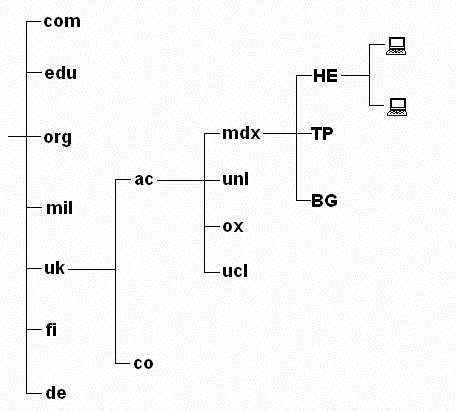
June 2010 Edition
Computer Science Department, University of Cape Town
 | MSc-IT Study Material June 2010 Edition Computer Science Department, University of Cape Town |
A sorting office in a small town may have a single bag into which all overseas letters are collected. This bag is then sent to the international sorting office where the contents are distributed into the various bags being sent to each country. The Internet also has a similar system, albeit more complex, known as the IP addressing schema and the Domain Name System (DNS). These are responsible for how packets find their way between two machines. To investigate the DNS we need to examine the destination address of a packet in more detail.
All IP addresses are composed of four bytes (32 bits) as follows:
10011110 01011110 00111011 00000001 (Binary notation)
158.94.59.1 (Dotted octet notation)
Given that an IP address is made up of four bytes, each of which can represent a number between 0 and 255, calculate how many possible IP addresses there are.
Solution can be found at the end of the Unit.
Any device wishing to receive an IP packet must be allocated one of these addresses.
Each packet of data must also contain two addresses: the source address and the destination address.
IP addresses are hierarchical. For example the hierarchy relevant to UCT is:
All addresses that begin with 137 are part of TENET (the Tertiary Education NETwork).
All addresses that begin with 137.158 are part of the UCT sub-network.
All computers that start with 137.158.96 are part of a LAN located in a small geographical area of UCT.
One particular computer has the unique address 137.158.96.99
Hierarchy allows each router to be aware of only the devices within its domain, and not all the 4.3 billion devices assigned IP addresses.
Unfortunately for our use of IP, humans are very poor at remembering numbers. To make addresses easier to remember, names are used to reference particular addresses. Just as IP is hierarchical, so are these names — although in this case the hierarchy exists to help human comprehension.
The figure below illustrates the hierarchy (known as the Domain Name System) in more detail.

The Domain Name System is a textual representation of IP addresses. However, for all the advantage of only needing to type in the DNS name of a network computer, it does not provide us with the location of, say, an HTML document; Universal Resource Locators (URL) are used to identify actual entities residing on a particular network node, rather than network nodes themselves.
Read up on IP addressing in your textbooks.